Field-Programmable Gate Arrays (FPGAs) play a pivotal role in modern digital design, offering unparalleled flexibility and customization. Programming FPGAs involves the use of various languages, each catering to different needs and preferences of developers. In this comprehensive overview, we’ll delve deeper into the key programming languages used in FPGA development.
1. VHDL (VHSIC Hardware Description Language)
VHDL, born out of the U.S. Department of Defense’s Very High-Speed Integrated Circuit (VHSIC) program, stands as a stalwart in FPGA programming. It enables designers to describe digital circuits and systems behaviorally, providing a robust and comprehensive approach to hardware design. VHDL is particularly well-suited for complex FPGA and ASIC designs due to its detailed and structured nature.
2. Verilog
Another heavyweight in the world of FPGA programming is Verilog. Like VHDL, Verilog is a hardware description language commonly used for its concise syntax and simulation capabilities. Its widespread adoption in both industry and academia makes it a versatile choice for FPGA development, offering effective ways to describe and simulate digital circuits.
3. SystemVerilog
Building on the foundation of Verilog, SystemVerilog enhances the language with features for design and verification. It has become a go-to language for large and complex FPGA projects, offering improved support for design methodologies and advanced verification capabilities. SystemVerilog’s versatility makes it well-suited for addressing the challenges of modern FPGA development.
4. C-based Languages
For developers more accustomed to traditional software languages, High-Level Synthesis (HLS) tools open the door to FPGA programming using C, C++, and OpenCL. This approach allows developers to leverage their software development skills while tapping into the parallel processing capabilities of FPGAs, making them more accessible for a broader audience.
5. Python
Python’s simplicity and readability have found a place in FPGA development, thanks to frameworks like MyHDL and Migen. These tools allow developers to use Python syntax to describe digital circuits, promoting rapid prototyping and experimentation. Python’s extensive ecosystem further enhances its appeal, enabling easy integration with other tools and libraries.
6. Bluespec
Bluespec stands out as a high-level hardware description language with a rule-based syntax. It enables concise and expressive descriptions of digital circuits, making it suitable for complex and highly parameterized designs. Bluespec’s unique approach facilitates faster development cycles and eases the management of intricate hardware designs.
7. Chisel
Chisel takes a distinctive approach by embedding a hardware construction language within the Scala programming language. This fusion of hardware description and a powerful programming language provides developers with a flexible and expressive toolset. Chisel’s functional programming features contribute to its appeal, offering a modern and scalable approach to FPGA design.
8. JHDL (Java Hardware Description Language)
Designed for those comfortable with Java, JHDL integrates hardware description into the Java ecosystem. Developers can create digital circuits using Java-like syntax, making it easier for those already versed in the language. JHDL’s compatibility with Java libraries and tools facilitates seamless collaboration between hardware and software components.
9. MyHDL
MyHDL brings the power of Python to FPGA development. By leveraging Python’s syntax, developers can describe digital circuits in a language that is both readable and accessible. MyHDL’s integration with Python’s extensive ecosystem opens up possibilities for using existing libraries and tools in FPGA projects, streamlining the development process.
10. OpenCL (Open Computing Language)
Initially developed for GPU parallel computing, OpenCL has found application in FPGA programming. It allows developers to harness FPGA parallel processing capabilities by providing a framework for expressing parallel algorithms. OpenCL is particularly relevant for FPGAs used in high-performance computing and signal processing applications, offering a portable and scalable programming model.
11. P4 (Programming Protocol-Independent Packet Processors)
In the domain of networking applications, P4 emerges as a language tailored for specifying packet processing on network devices. While initially targeted at SDN switches, P4 is gaining traction in FPGA programming for networking applications, providing a higher level of programmability and customization to meet evolving network demands.
Conclusion
The diverse programming languages available for FPGA development cater to a spectrum of preferences, backgrounds, and project requirements. Whether opting for traditional HDLs like VHDL and Verilog, exploring the flexibility of C-based languages, or embracing newer languages like Python and Chisel, developers have a rich toolkit to unlock the full potential of FPGAs across various applications. The choice of language ultimately depends on the specific project goals, design complexity, and the expertise of the development team.
Hire the Best Engineers with RunTime Recruitment
Our expert team of engineers-turned-recruiters offers in-depth knowledge of technical recruiting in the engineering industry. If your company is looking to recruit highly skilled engineers worldwide, contact us today and we will do the sourcing for you. Or if you’re an engineer looking for new opportunities, you can check RunTime Recruitment’s job site for job vacancies.









